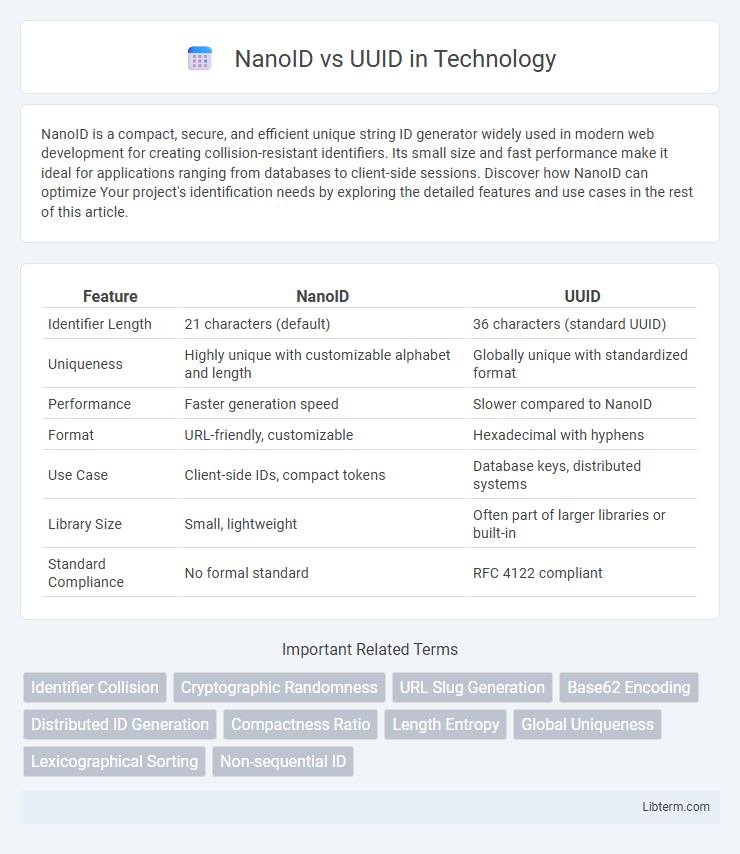NanoID is a compact, secure, and efficient unique string ID generator widely used in modern web development for creating collision-resistant identifiers. Its small size and fast performance make it ideal for applications ranging from databases to client-side sessions. Discover how NanoID can optimize Your project's identification needs by exploring the detailed features and use cases in the rest of this article.
Table of Comparison
| Feature | NanoID | UUID |
|---|---|---|
| Identifier Length | 21 characters (default) | 36 characters (standard UUID) |
| Uniqueness | Highly unique with customizable alphabet and length | Globally unique with standardized format |
| Performance | Faster generation speed | Slower compared to NanoID |
| Format | URL-friendly, customizable | Hexadecimal with hyphens |
| Use Case | Client-side IDs, compact tokens | Database keys, distributed systems |
| Library Size | Small, lightweight | Often part of larger libraries or built-in |
| Standard Compliance | No formal standard | RFC 4122 compliant |
Introduction to Unique Identifiers
Unique identifiers such as NanoID and UUID serve as essential tools for generating distinct, collision-resistant keys in databases and distributed systems. NanoID offers a compact, URL-friendly, and highly customizable alphanumeric string, typically shorter in length, which optimizes for both uniqueness and readability. UUIDs, standardized by RFC 4122, provide a fixed 128-bit value widely adopted for global uniqueness across diverse applications, ensuring compatibility and a low probability of collision.
What is NanoID?
NanoID is a compact, URL-friendly unique string ID generator designed to produce shorter, collision-resistant identifiers compared to traditional UUIDs. It leverages a customizable alphabet and variable length, typically generating IDs with high entropy in fewer characters, optimizing both space and uniqueness. Widely used in web applications for database keys and session tokens, NanoID balances compactness with cryptographic security for efficient identification.
What is UUID?
UUID (Universally Unique Identifier) is a 128-bit number used to uniquely identify information in computer systems, standardized by RFC 4122. It provides a high degree of uniqueness through various versions, including time-based and random variants, commonly represented as a 36-character string with five groups separated by hyphens. UUIDs are widely used for database keys, distributed systems, and software development where unique identification is critical to prevent collisions.
Size and Length Comparison
NanoID generates unique identifiers with a default length of 21 characters, significantly shorter than the standard 36-character UUID format, resulting in more compact and URL-friendly strings. While UUIDs use a fixed 128-bit structure represented as 36 characters including hyphens, NanoID's flexible length allows customization, often maintaining similar collision resistance with fewer characters. This size efficiency in NanoID reduces storage requirements and improves readability without compromising uniqueness.
Collision Probability: NanoID vs UUID
NanoID offers a significantly lower collision probability compared to traditional UUIDs by generating shorter, URL-friendly strings with customizable alphabets and lengths, enhancing uniqueness in distributed systems. UUID version 4 relies on random number generation with a fixed length of 128 bits, resulting in a collision probability of 1 in 2^122, which is generally low but less flexible than NanoID's adjustable parameters. For applications requiring high scalability and minimal collision risks, NanoID's customizable approach ensures stronger uniqueness guarantees over UUID's standardized format.
Performance and Speed
NanoID offers significantly faster performance compared to UUID generation, especially in environments where speed is critical, such as client-side applications. NanoID's smaller token size and efficient algorithm reduce overhead, resulting in quicker generation times and lower memory usage. Benchmark tests consistently show NanoID outperforming UUID libraries by up to 3x in generation speed while maintaining strong uniqueness guarantees.
Security Considerations
NanoID generates shorter, URL-friendly IDs with a customizable alphabet, reducing predictability and enhancing security against brute-force attacks compared to traditional UUIDs. UUIDs, especially version 4, use random or pseudo-random numbers but have a fixed length and limited entropy, making them potentially less secure in scenarios requiring high uniqueness and unpredictability. For security-sensitive applications, NanoID's configurable entropy levels and collision resistance provide a more robust option than standard UUID formats.
Encoding and Readability
NanoID uses a smaller, customizable alphabet based on URL-safe characters, resulting in a shorter, more concise string compared to UUID's fixed 36-character hexadecimal format with hyphens. This encoding efficiency enhances NanoID's readability and usability in URLs and user interfaces, while UUID's standardized encoding remains widely recognized for compatibility. NanoID's alphanumeric tokens reduce visual clutter, improving human readability without compromising uniqueness.
Use Cases and Adoption
NanoID is ideal for web applications requiring compact, URL-friendly unique identifiers with high collision resistance, commonly used in client-side databases and real-time systems. UUID remains prevalent in distributed systems, enterprise applications, and databases where standardization and interoperability across diverse platforms are critical. Adoption of NanoID has grown in modern JavaScript frameworks due to its smaller size and performance benefits, while UUID continues to dominate legacy systems and environments needing globally unique identifier standards.
Choosing Between NanoID and UUID
Choosing between NanoID and UUID depends on the requirements for collision resistance, size, and readability; NanoID generates shorter, URL-friendly unique IDs with customizable length, making it ideal for web applications where compactness and aesthetics matter. UUIDs, standardized as 128-bit identifiers, provide universally unique values widely supported across platforms and systems, ensuring high collision resistance for distributed environments. Developers prioritize NanoID for front-end or client-side usage with performance constraints, while UUIDs remain preferred for backend systems demanding standardized, globally unique identifiers.
NanoID Infographic

 libterm.com
libterm.com